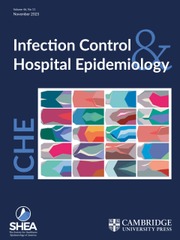Crossref Citations
This article has been cited by the following publications. This list is generated based on data provided by
Crossref.
Sullivan, Timothy
Ichikawa, Osamu
Dudley, Joel
Li, Li
and
Aberg, Judith
2018.
The Rapid Prediction of Carbapenem Resistance in Patients With Klebsiella pneumoniae Bacteremia Using Electronic Medical Record Data.
Open Forum Infectious Diseases,
Vol. 5,
Issue. 5,
Mansori, Kamyar
Ayubi, Erfan
and
Safiri, Saeid
2018.
Predicting Multidrug-Resistant Gram-Negative Bacterial Colonization and Associated Infection on Hospital Admission: Methodological Issues.
Infection Control & Hospital Epidemiology,
Vol. 39,
Issue. 2,
p.
241.
Tseng, Wen-Pin
Chen, Yee-Chun
Chen, Shang-Yu
Chen, Shey-Ying
and
Chang, Shan-Chwen
2018.
Risk for subsequent infection and mortality after hospitalization among patients with multidrug-resistant gram-negative bacteria colonization or infection.
Antimicrobial Resistance & Infection Control,
Vol. 7,
Issue. 1,
Boldt, Anne-Cathérine
Schwab, Frank
Rohde, Anna M.
Kola, Axel
Bui, Minh Trang
Märtin, Nayana
Kipnis, Marina
Schröder, Christin
Leistner, Rasmus
Wiese-Posselt, Miriam
Zweigner, Janine
Gastmeier, Petra
Denkel, Luisa A.
and
Chaturvedi, Vishnu
2018.
Admission prevalence of colonization with third-generation cephalosporin-resistant Enterobacteriaceae and subsequent infection rates in a German university hospital.
PLOS ONE,
Vol. 13,
Issue. 8,
p.
e0201548.
Blanco, Natalia
Johnson, J. Kristie
Sorkin, John D.
Lydecker, Alison D.
Levy, Lauren
Mody, Lona
and
Roghmann, Mary-Claire
2018.
Transmission of resistant Gram-negative bacteria to healthcare personnel gowns and gloves during care of residents in community-based nursing facilities.
Infection Control & Hospital Epidemiology,
Vol. 39,
Issue. 12,
p.
1425.
Pfang, Bernadette G.
García-Cañete, Joaquín
García-Lasheras, Julia
Blanco, Antonio
Auñón, Álvaro
Parron-Cambero, Raul
Macías-Valcayo, Alicia
and
Esteban, Jaime
2019.
Orthopedic Implant-Associated Infection by Multidrug Resistant Enterobacteriaceae.
Journal of Clinical Medicine,
Vol. 8,
Issue. 2,
p.
220.
Zhang, Man
Yang, Huai
Mou, Xia
Wang, Lu
He, Min
Zhang, Qunling
Wu, Kaiming
Cheng, Juan
Wu, Wenjuan
Li, Dan
Xu, Yan
Chao, Jianqian
and
Leekha, Surbhi
2019.
An interactive nomogram to predict healthcare-associated infections in ICU patients: A multicenter study in GuiZhou Province, China.
PLOS ONE,
Vol. 14,
Issue. 7,
p.
e0219456.
Goodman, Katherine E.
Lessler, Justin
Harris, Anthony D.
Milstone, Aaron M.
and
Tamma, Pranita D.
2019.
A methodological comparison of risk scores versus decision trees for predicting drug-resistant infections: A case study using extended-spectrum beta-lactamase (ESBL) bacteremia.
Infection Control & Hospital Epidemiology,
Vol. 40,
Issue. 4,
p.
400.
Burillo, Almudena
Muñoz, Patricia
and
Bouza, Emilio
2019.
Risk stratification for multidrug-resistant Gram-negative infections in ICU patients.
Current Opinion in Infectious Diseases,
Vol. 32,
Issue. 6,
p.
626.
Yakovlev, S. V.
Suvorova, M. P.
and
Bykov, A. O.
2020.
Infections Caused by Carbapenem-Resistant Enterobacterales: Epidemiology, Clinical Significance, and Possibilities for Antibiotic Therapy Optimization.
Antibiotics and Chemotherapy,
Vol. 65,
Issue. 5-6,
p.
41.
González del Castillo, Juan
Julián-Jiménez, Agustín
Gamazo-Del Rio, Julio Javier
García-Lamberechts, Eric Jorge
Llopis-Roca, Ferrán
Guardiola Tey, Josep María
Martínez-Ortiz de Zarate, Mikel
Navarro Bustos, Carmen
Piñera Salmerón, Pascual
Álvarez-Manzanares, Jesús
Ortega Romero, María del Mar
Ruiz Grinspan, Martin
García Gutiérrez, Susana
Martín-Sánchez, Francisco Javier
and
Candel González, Francisco Javier
2020.
A multidrug-resistant microorganism infection risk prediction model: development and validation in an emergency medicine population.
European Journal of Clinical Microbiology & Infectious Diseases,
Vol. 39,
Issue. 2,
p.
309.
Ceraudo, M.
Prior, A.
Balestrino, A.
Anania, P.
Camera, M.
Fiaschi, P.
Gatto, F.
Riccardi, N.
Zona, G.
and
Criminelli Rossi, D.
2021.
Ultra-short antibiotic prophylaxis guided by preoperative microbiological nasal swabs in endoscopic endonasal skull base surgery.
Acta Neurochirurgica,
Vol. 163,
Issue. 2,
p.
369.
Karaba, Sara M.
Goodman, Katherine E.
Amoah, Joe
Cosgrove, Sara E.
and
Tamma, Pranita D.
2021.
StenoSCORE: Predicting Stenotrophomonas maltophilia Bloodstream Infections in the Hematologic Malignancy Population.
Antimicrobial Agents and Chemotherapy,
Vol. 65,
Issue. 8,
Moschou, Aikaterini
Ioannou, Petros
Moraitaki, Eleni
Stafylaki, Dimitra
Maraki, Sofia
Samonis, George
and
Kofteridis, Diamantis P.
2021.
Rectal Colonization by Drug Resistant Bacteria in Nursing Home Residents in Crete, Greece.
Tropical Medicine and Infectious Disease,
Vol. 6,
Issue. 3,
p.
123.
Salazar-Ospina, L.
Vanegas, J.M.
and
Jiménez, J.N.
2021.
High intermittent colonization by diverse clones of β-lactam-resistant Gram-negative bacilli suggests an excessive antibiotic use and different sources of transmission in haemodialysis patients.
Journal of Hospital Infection,
Vol. 107,
Issue. ,
p.
76.
Balada-Llasat, Joan-Miquel
Stamas, Nicole
Vincent, Tom
Timbrook, Tristan T.
Saiontz-Martinez, Cynthia
Hemmert, Rachael B.
and
Berger, Ariel
2022.
Epidemiology and Economic Outcomes Associated with Timely versus Delayed Receipt of Appropriate Antibiotic Therapy among US Patients Hospitalized for Native Septic Arthritis: A Retrospective Cohort Study.
Antibiotics,
Vol. 11,
Issue. 12,
p.
1732.
Cano, Ángela
Gutiérrez-Gutiérrez, Belén
Machuca, Isabel
Torre-Giménez, Julián
Gracia-Ahufinger, Irene
Natera, Alejandra M.
Pérez-Nadales, Elena
Castón, Juan Jose
Rodríguez-Baño, Jesús
Martínez-Martínez, Luis
Torre-Cisneros, Julián
and
Wesley Long, S.
2022.
Association between Timing of Colonization and Risk of Developing Klebsiella pneumoniae Carbapenemase-Producing K. pneumoniae Infection in Hospitalized Patients.
Microbiology Spectrum,
Vol. 10,
Issue. 2,
Sirichayanugul, Taranee
Srisawat, Chansinee
Thummakomut, Chawin
Prawang, Abhisit
Huynh, Nina S
Saokaew, Surasak
Phisalprapa, Pochamana
and
Kanchanasurakit, Sukrit
2022.
Development and internal validation of simplified predictive scoring (ICU-SEPSA score) for mortality in patients with multidrug resistant infection.
Frontiers in Pharmacology,
Vol. 13,
Issue. ,
Spoto, Silvia
Daniel Markley, John
Valeriani, Emanuele
Abbate, Antonio
Argemi, Josepmaria
Markley, Roshanak
Fogolari, Marta
Locorriere, Luciana
Anguissola, Giuseppina Beretta
Battifoglia, Giulia
Costantino, Sebastiano
Ciccozzi, Massimo
Bustos Guillén, César
and
Angeletti, Silvia
2022.
Active Surveillance Cultures and Procalcitonin in Combination With Clinical Data to Guide Empirical Antimicrobial Therapy in Hospitalized Medical Patients With Sepsis.
Frontiers in Microbiology,
Vol. 13,
Issue. ,
Papafotiou, Chrysanthe
Roussos, Sotirios
Sypsa, Vana
Bampali, Sofia
Spyridopoulou, Kalliopi
Karapanou, Amalia
Moussouli, Anastasia
Samarkos, Michael
Daikos, George L
and
Psichogiou, Mina
2022.
Predictive score for patients with carbapenemase-producing enterobacterales colonization upon admission in a tertiary care hospital in an endemic area.
Journal of Antimicrobial Chemotherapy,
Vol. 77,
Issue. 12,
p.
3331.


